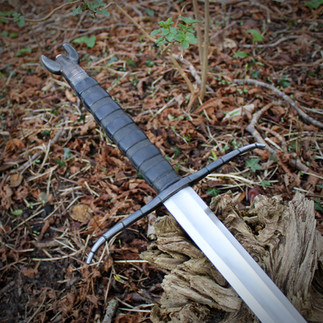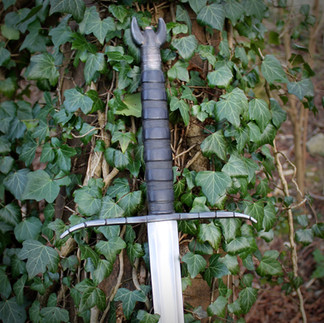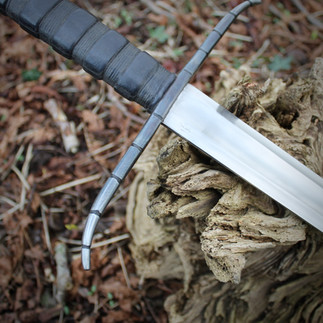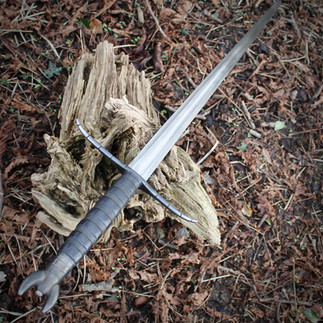The Eoderma LongSword
- Alicia Adams
- Apr 1, 2021
- 3 min read

This longsword is a welcome return to the world of pure fantasy, with its insectoid imagery and nod to a cyber aesthetic. The commission was made to an open brief, with only the request that we work in a reference to a badger-striped robot earwig, allowing Chris the creative license to create a truly one-of-a-kind piece.
The result is an aesthetically unusual yet straightforwardly functional weapon, with the traditional fishtail pommel exaggerated to take on a pincer-like form, and the quillons segmented to subtly evoke the legs or antennae of an insect.
Named for Eodermaptera, an extinct suborder of earwigs who walked the earth from the Middle Jurassic to Mid Cretaceous periods, the sword is balanced with rotational actions and binding manoeuvres in mind, with 8mm stock allowing the blade to rotate well and remain relatively stiff in the forte without compromising weight or safety.
Please see our pricing structure for an idea of what a similar sword would cost.
∴ Specs ∴

Total length: 123cm
Blade length: 95cm
Blade width at base: 4cm
Blade stock: 8mm
Grip length: 18.5cm
Grip and pommel: 26.5cm
Quillon span: 26cm
Weight: 1410g
Point of Balance: 10.5cm
Fencing flex
2mm edges
Swollen tip
∴ Notes ∴

The hand-forged heat-treated guard and pommel are blackened to a matte finish. The quillons are straight with downturned terminals, and segmented with hand-carved grooves, giving an insectoid effect. The fishtail pommel is carved into a shape reminiscent of earwig pincers, and features hand-carved ribbing to the base and a copper peening block.
The oak grip is wrapped first in linen twine , and then in black leather, which has been bound with cord and wet-formed into a striped and textured pattern.
The blade is adorned with a single, broad, central fuller.
∴ Gallery ∴
∴ A Creeping Feeling ∴

By this point the corridors have all blurred into a singular indistinct passageway, its rounded marble walls pristine and unmarked, save for the occasional six-sided doorway. Not six-sided like a hexagon, you think with a twinge of superstitious discomfort, but like a coffin. And each with the same strange sigil carved into its lintel - the crude image of a six-legged insect, cruel pincers extending from its elongated abdomen.
A crackle over your headset makes you jump, the sound echoing uncannily down the tunnel.
“I think this is the one,” reports the muffled voice of your research partner. Safe above ground, she’s been monitoring your progress via electronic trackers, guiding you through the geometric turns of the six-sided maze that you are too close to decipher.
“You sure about this?” you say, pausing before yet another identical coffin-shaped door.
“I’d wager my life,” she replies.
“Too bad it’s mine that’s on the line,” you jest, before taking a deep breath and stepping over the threshold.
Nothing happens. You open your eyes, uncurl tightly clenched fists, let your shoulders drop. The atrium is eerie white, just as the corridor that led to it. White and echoingly empty, save for the plinth in its centre: an altar, perhaps? Or simply a convenient surface for the sword that rests upon it.
“You got it?” your assistant asks.
You murmur an affirmative as your fingers run over the weapon. It is as lovely as it is grotesque, the tapering curves of its crossguard segmented by carved lines - almost like insect antennae, you think. The ridged grip rises to a a split pommel, two smooth, dark fangs extending from its ribbed centre. No, not fangs, you realise, recalling the strange sigil above the doorways. Pincers.
You can’t say how long you’ve been aware, on some unconscious level, of the rising sound behind you. You only know it’s no surprise. Like a distant and tiny orchestra tuning, the woozy discord of multitudes - a symphony of scuttling legs. You’ve seen enough movies to know how this ends. What can you do but clutch the sword close to you, grit your teeth, and await the swarm?












